12 mins read
Trump’s USAID purge has revealed US scheming in Kiev, but won’t stop it
It’s fun to watch “independent” media and NGOs get outed, but Washington will always find ways to manipulate others
17 mins read
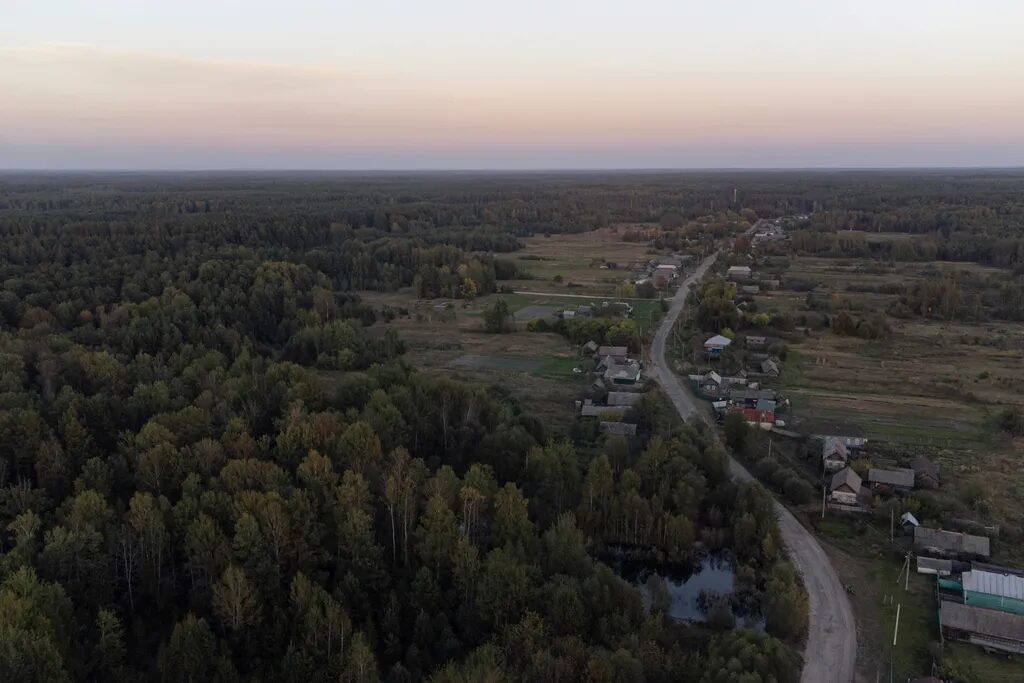
It was early September 2023 – Nataliya Namys remembers exactly – when her stepson Danylo called to tell her of a strange dream he had had. He made the call from where his anti-tank unit had found quarters in the embattled region of Donbas. She was almost 800 kilometers away, alone at home in Horodnya, a town in the northern tip of Ukraine. Danylo had poor reception at the front and had called from an unknown number.
“He had dreamed that there would be a large funeral here in Horodnya,” Namys says. The 42-year-old has a heart condition and suffers from diabetes, relying on insulin to regulate her blood-sugar levels. She also needs a scooter for longer distances. Danylo thought his dream was about her.
Namys said that she had to calm him down. “I’m not going to die,” she told him. “I’ll be there when you return.” She sobs repeatedly, even when the tears don’t flow.
A heavyset woman with dyed-blonde hair, Namys is sitting on the bank of the Chybryzh River, which winds its way through Horodnya. The town, located in a thickly forested area just 30 kilometers from where the borders of Ukraine, Russia and Belarus meet, is home to 10,000 people. Bumpy roads lead through the surrounding villages, some of which have been abandoned.
It is a sunny fall day and Namys is taking a break from work. Together with a handful of other women, she weaves camouflage netting for the army on a volunteer basis. It’s the only thing that helps take her mind off Danylo.
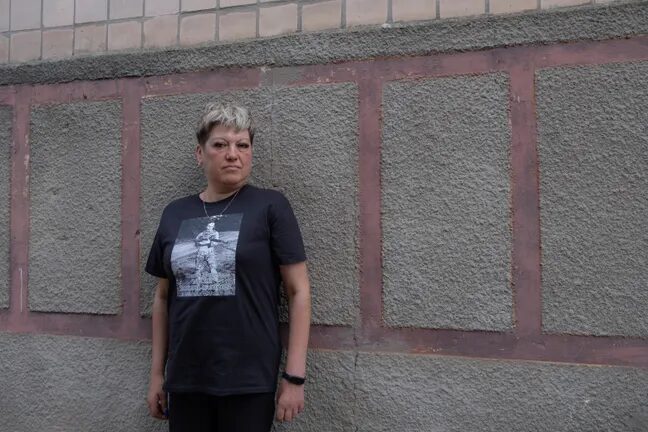
The boy’s biological mother left the family with he was just two years old and Nataliya Namys married his father. She raised Danylo and his older sister like they were her own, she says. She recalls a boy who played football and planted tulips, roses and lilies in the garden – and who began dreaming of joining the army from an early age.
In April 2023, having turned 18, Danylo voluntarily enlisted. “We did everything we could to change his mind,” Namys says. “But he wouldn’t listen.”
Training in the western Ukrainian region of Lviv took six weeks. And then, Danylo was sent to the front in Donbas, soon thrown into some of the most intense battles of the war. As a soldier in the 1st Tank Brigade, he fought in Bakhmut, Mar’inka and Pokrovsk.
In Mar’inka, a piece of shrapnel bored its way into his arm. Later, he suffered a concussion but immediately returned to the front. On September 7, 2023, he was struck by a grenade, hardly a month after his 19th birthday and just two days after his phone call with his stepmother. A large funeral was held in Horodnya, just like in Danylo’s dream.
His own.
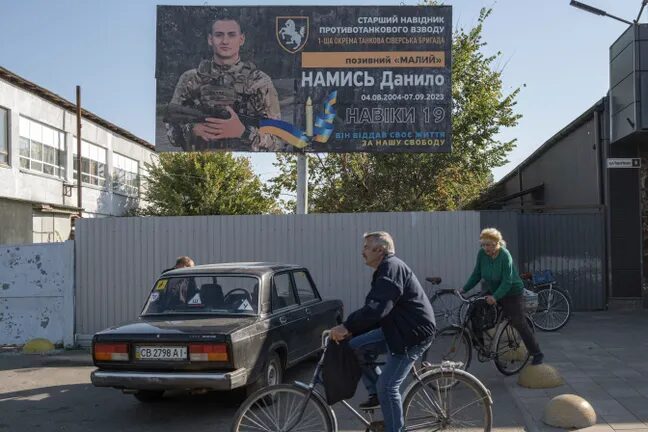
He is now commemorated in town with a large billboard, rising over the parking lot of the supermarket where the few local youths gather in the evenings. It shows a young man in uniform holding an assault rifle, his hair closely cropped, a determined expression on his face. The inscription reads: Danylo Namys, radio callsign: “The Kid” – “Forever 19.”
Danylo Namys is just one of several tens of thousands of Ukrainians who have been killed in this war. Funerals of fallen soldiers have long since become routine. But for Ukraine, the loss of young people is particularly hard to cope with. The war is robbing the country of the smallest generation in its recent history.
Even before the Russian invasion, Ukraine was facing a demographic crisis. The population began aging way back in the 1960s. Then, in the 1990s, the disintegration of the Soviet Union led to economic collapse, leaving millions of men and women without a future. They had fewer children, or they left the country.
The Russian invasion has now turned the demographic crisis into a catastrophe. Almost 7 million people, mostly women and children, have fled abroad since February 24, 2022, the day of the invasion. At least 5 million Ukrainians are now living under Russian occupation, cut off from the rest of the country by trenches and minefields. On top of that are the tens of thousands of civilians who have been killed and the up to 100,000 fallen soldiers.
In the early 1990s, early in the country’s independence, Ukraine had a population of 51.5 million. Today, only an estimated 29 million people live in Ukrainian areas under Kyiv’s control. The populations of industrialized countries begin shrinking when the birth rate falls below 2.1 children per woman, and in the EU, the rate is 1.5. In Ukraine, though, the birthrate has fallen below one, according to estimates by leading demographer Ella Libanova, head of the Institute for Demography and Social Studies in Kyiv.
The country is running out of people.
Politicians are well aware of the situation. Only men aged 25 and older are required to enlist, even though commanders at the front need every healthy recruit they can get. The age limit was even 27 until last spring, with parliament and the government only reluctantly lowering it. Danylo Namys’ radio callsign, “The Kid,” was not chosen at random: The average age of Ukrainian soldiers is 40.
Her stepson isn’t just the youngest casualty from Horodnya, says Natalya Namys, but also in the entire Chernihiv region. The whole community is mourning his death. Just recently, a football tournament was held in his memory.
It is a particularly tough blow here. The region is structurally weak, with plenty of trees, but not many people.
Andriy Bohdan is in good spirits despite it all, gushing about the region he calls home. The 57-year-old has been mayor of Horodnya for the last 22 years and is also head of the “hromada” of the same name, a kind of federation of municipalities that includes the town and all of the surrounding villages, right up to the borders with Russia and Belarus. Bohdan receives his visitors in a sparsely furnished building that serves as his office, his mobile phone ringing without pause. Files are piled up on the tables and assistants are rushing back and forth through the offices. The 2025 budget is currently being compiled.
A man with sharp eyes and a broad smile, Bohdan says that much has changed for the better since Ukraine gained its independence in 1991, particularly in people’s minds. “The work ethic is better than it used to be, as is the way we treat nature and the environment,” he says.
Horodnya is a town with clean, broad streets flanked by well-tended gardens in front of small wooden houses and tidy playgrounds. Empty houses and even completely abandoned hamlets can be found in the forests surrounding the town. The countryside is deserted but not neglected.
“The natural scenery is beautiful,” Bohdan says, and the people are tough and hard-working. “There is a lot of potential here, for tourism, for example,” he says. “But the demographic situation is a big problem.”
Bohdan has been around for every step of the downfall. In the 1980s, as the Soviet Union was nearing its end, 16,000 people still lived in town, a third more than today. An engineer by training, Bohdan’s first job was with Rubin, a Moscow-based television manufacturer that had a subsidiary in town. “In the Soviet Union, our city was the only district capital where color televisions were produced,” he says proudly.
But then, the Soviet Union collapsed. The factory went broke in 1997, the mayor says, costing 2,400 people their jobs. One year later, the military air base also closed down, the second largest employer in the region at the time. “Seven-hundred people were without work and all the soldiers were gone,” Bohdan says. Suddenly, Horodnya had one of the highest unemployment rates in all of Ukraine.
“The market economy was only slowly gaining a foothold here,” says Bohdan. Many have left, he says, finding jobs in places like Poland, Italy or elsewhere in Europe, the men as seasonal laborers, the women in nursing.
The losses have continued into the new millennium – and were then magnified by the Russian invasion. Horodnya lies on a highway that connects Russia directly with Kyiv, the Ukrainian capital some 240 kilometers to the south. “When the war broke out, the Russians weren’t here within days, they were here within hours,” says Bogdan. The first tanks reached the outskirts of town by 8 am on the morning of the invasion, he says.
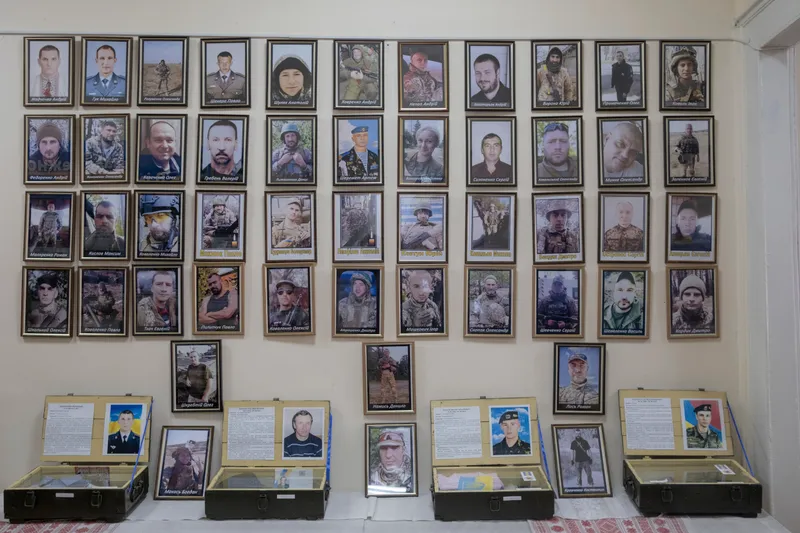
The town spent 37 days under Russian occupation, a period of isolation, according to Bohdan. People came together to bake bread and cooperated to acquire fuel. There was hardly any fighting in the region.
But the war affected Horodnya in different ways. Belarus opened its border, opening a route for the first residents to begin fleeing to the EU, even before the occupation had ended. Mostly, says Bohdan, they were members of minority communities who had relatives or friends abroad: Adventists, Baptists and Roma.
People continued leaving after the occupiers withdrew in early April 2022. Other residents were conscripted into the military or volunteered, like Danylo Namys. Some 75 soldiers from Horodnya have fallen in battle, says Andriy Bohdan, with around 50 more missing.
The mayor estimates that around 10 percent of Hromada residents have left since the beginning of the war, and the effect on the economy has been significant. “These people are among the most productive. We need them in the fields, in the forest, in the lumber industry.”
The site of the former military academy’s airstrip is in a forested area on the outskirts of town. Lumberyard operator Oleg Korotky bought it in 2003 and set up shop in the hangars and on the tarmac. Trucks are parked outside the halls, saws are screeching and the smell of spruce pervades the drying chambers.
Korotky, a robustly built, taciturn 55-year-old with suspenders and a firm handshake, sinks into the chair behind his desk. His office is adorned with a map of Ukraine hanging on the wall, Orthodox icons and an aquarium. It’s not a good time for business, he says.
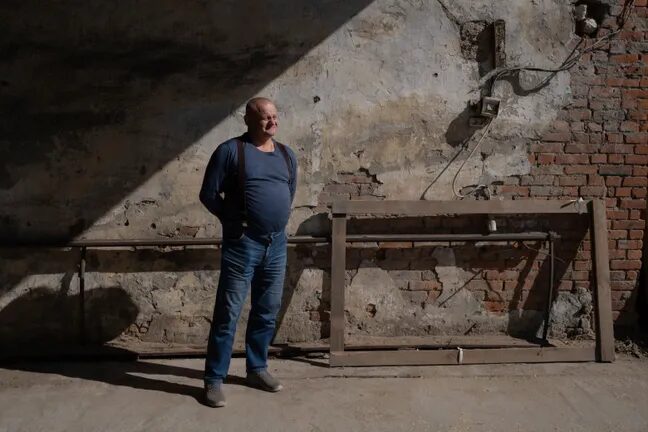
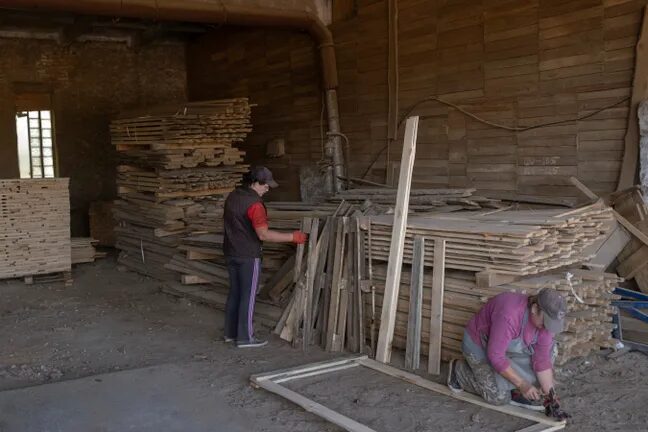
Korotky’s business focuses on the processing of lumber. His company harvests some of the birch and spruce itself but buys most of it on the open market. In his factory, it is turned into lumber, packaged up and shipped out. He produces coffins for the local market, but most of his wood is exported, he says. In France, it is turned into expensive furniture, in Spain it is used to produce the caps for designer creams.
Before the war, Korotky says, he used to export to other countries as well, like Turkey, Egypt, India and China. “You used to be able to pack the container full right here and put it on the train that would head straight to the Black Sea.” After the Russian invasion, although, the shipping lanes were blocked for a time, and Korotky began trucking his wood to the EU. These days, Ukrainian products can once again be exported via the Black Sea ports, “but now, the price is too high,” Korotky complains.
And that is far from his only problem, he continues. Of the 30 people he employed before the war, only half remain. Two were killed at the front and two others are missing. Still others have been scripted or have gone underground to avoid being sent to the front.
“Of course it hurts,” says Korotky with a sigh. “They were technically skilled people, specialists in transportation and workmanship.” And such people are missing in the entire region: The lumber industry is the most important sector in Horodnya alongside agriculture.
To compensate for the losses, Korotky has turned to hiring women and older workers. In one of his halls, a woman in her 60s is assembling palettes for the wood. Two of his drivers are also over 60, says Korotky. “Many of those now working here are already of retirement age,” he says.
It is a trend that can be observed across the country, says Ella Libanova, the demographer. From the perspective of employers, she says, the perfect worker is someone who has already turned 60. “Such people can no longer be conscripted,” she says.
In the villages surrounding Horodnya, the elderly are frequently the only ones left. When she got started here in the late 1990s, says village head Lyudmila Kutsa, there was more of everything: more people, more houses, more life.
The 60-year-old is from central Ukraine. In the mid-1980s, she came to Chernihiv for her studies, the capital of the eponymous region located an hour’s drive south of Horodnya. “That’s how the Soviet Union was,” she says. “You couldn’t choose where you were sent.” Kutsa started her career as a math teacher, met her husband here and settled down in the region.
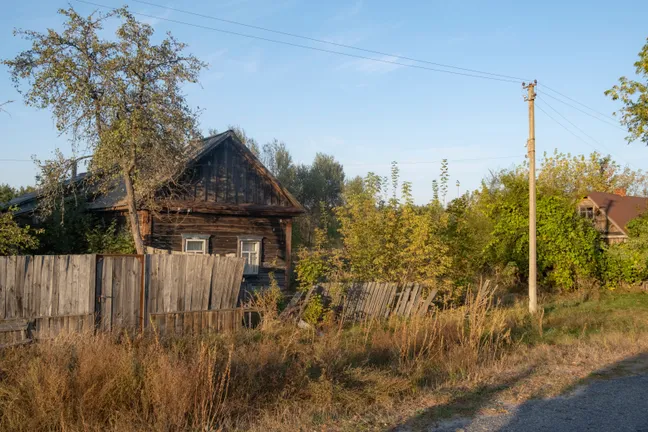
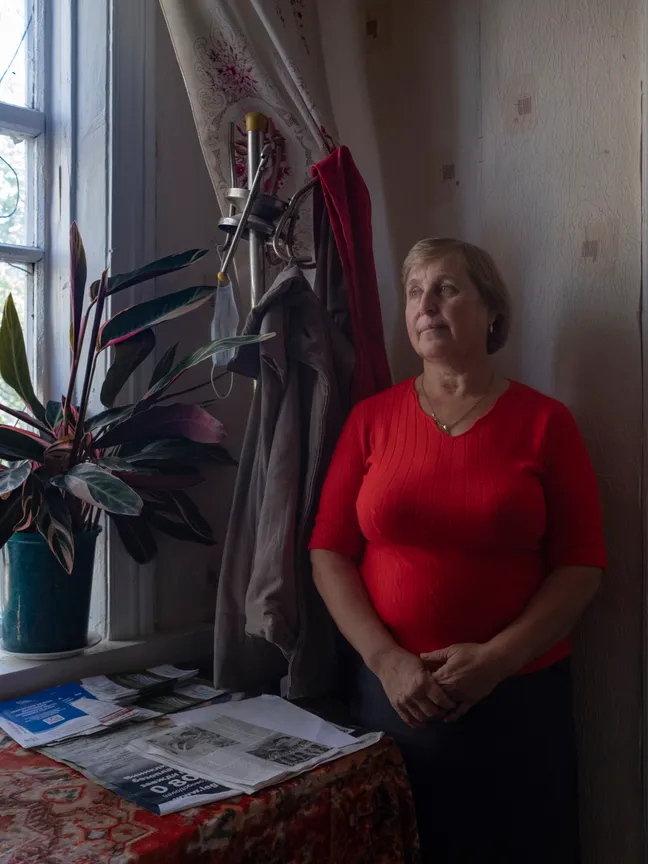
Since 1998, she has been responsible for nine tiny hamlets in the forest. There used to be 10, but one of them was abandoned completely. Another is home to just a single person, with others having populations of three or five. Some 800 people used to live in the area, but now the total is below 300 and only two of nine village shops remain open. “People used to come to me,” she says, “but now I have to visit them.”
Kutsa’s commute takes her along a track covered in deep sand that can quickly bog down those who misjudge the curves. It runs past abandoned wooden houses, some of which are slowly succumbing to entropy. Others have almost disappeared in the undergrowth, as although the forest is trying to swallow them up.
There is hardly a hat she doesn’t wear, says Kutsa. Sometimes she plays the role of social worker, other times she maintains order or acts as psychologist. This morning, she helped put children on school buses taking them to Horodnya. The day before, she mediated a spat between neighbors. “I drive through the area and try to solve people’s problems,” she says.
Many of those Kutsa visits have relatives abroad: Her secretary’s daughter emigrated to Sweden years ago and the librarian’s son left for Israel in 2020 to work in construction. A soldier on home leave asks Kutsa on this day for advice about buying a home; his daughter grew up lives in Poland.
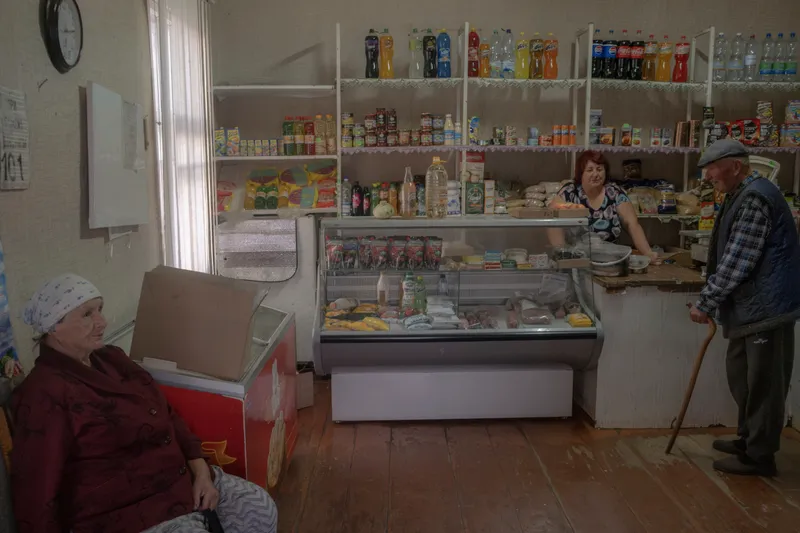
In the last five or six years, she says, around 20 people from her federation of villages have left for the EU, almost 10 percent of the entire population. “It works like this: A family heads out, settles abroad and then passes along their contacts. Once the path is established, others follow.”
Eight villagers have fled since the Russian invasion, she says. One, a soldier, was killed and two more are missing.
Russian attacks claim lives every day. But emigration and flight are contributing to Ukraine’s depopulation much more strongly than the fighting on the front lines. Sometimes, a single family experiences both.
Nataliya Marchenko, 49, left home on April 12, 2022, not even two weeks after Russian troops withdrew from the region. Together with her husband and five daughters, she boarded a minibus organized by the city and fled. And Horodnya had lost one of its few remaining large families.
“I only had one concern,” says a crying Marchenko over the phone, “the safety of my children.” She had already lost one.
On March 1, 2022, with the war less than a week old, a Russian missile struck the air academy in the Ukrainian city of Kharkiv. One of the students was Marchenko’s son Anatoliy, 24, who went by Tolya and was studying to become an engineer. He immediately began digging through the rubble trying to pull out survivors when a second missile hit the facility and killed him. His hometown of Horodnya was occupied by Russian troops and his family hardly had any contact with the outside world. Tolya was buried near Kyiv six days after his death.
The family, Nataliya Marchenko quickly decided, would flee at the first opportunity. Immediately after the occupation ended, she gave up her job as a shop assistant and her husband, a lumberjack, also quit. They gathered their daughters and left the country.
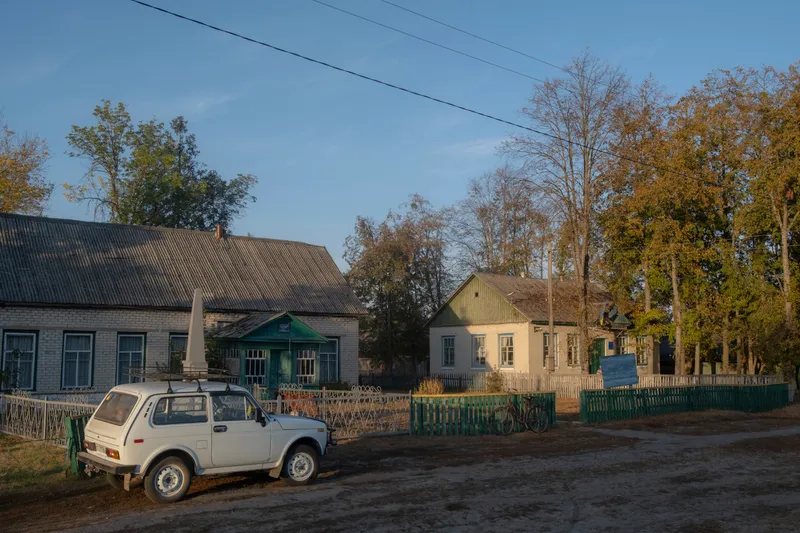
Marchenko tells her story via WhatsApp. The family settled in northern Spain, not far from Pamplona. In contrast to many others from Ukraine, their journey did not devolve into an odyssey. Marchenko’s daughter had spent some time in Spain while still in school as part of a sponsorship program and her former hosts offered the family a place to stay.
“Life here is good. Our hosts are wonderful,” says the Ukrainian. The family is living free of charge in a two-story house, she says. And Marchenko’s job in a care home is just a five-minute walk away. Her husband found work in a slaughterhouse. Their daughters started school just three days after their arrival and have long since become fluent in Spanish.
Still, says Marchenko, she is constantly thinking about home. Ukraine is where her son is buried. Relative call every day.
She says she doesn’t know if they will ever go back. “We had plans in Ukraine, but they ended in nothing,” says Marchenko. “We’re not going to do that again.”
In the mid-term, she hopes that Ukraine becomes a member of the European Union. “It would be best for our family if we could easily travel home without all the paperwork – even if only for a visit.”
Ukraine’s demographic fate does, in large measure, depend on its partners in the West. A certain degree of depopulation is unavoidable, demographer Libanova believes. The population is simply too old. This trend is far from unique to Ukraine. Russia is also facing similar problems, although the country’s population is four times larger.
There are, however, tools available to Ukraine to fight against extreme depopulation, Libanova believes. “Not only must Ukrainians be encouraged to return, but people from other countries must be attracted as well,” the expert says. An improvement in life quality could also contribute to a rising birthrate.
Before that happens, however, the war must come to an end. The security guarantees that Ukraine receives will then be decisive. People would hardly return to a country facing an infinite threat from Russia. Indeed, more would likely leave. EU membership would be crucial for the country’s economic future, says Libanova. “It would stimulate growth and modernize the economy.”
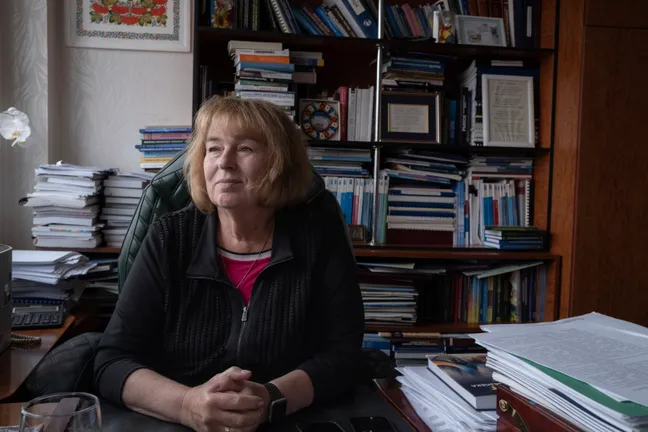
Like many of their compatriots, the people of Horodnya have also long been placing their hopes in Europe. Before the war, Nataliya Namys’ fallen son-in-law Danylo had dreamed of traveling the Continent. Oleg Korotky, the lumber mill owner, has a son in Poland and customers in the EU. The war forced the Marchenko family into a balancing act between Europe and their home – and they would now like to see the two grow together.
Andriy Bohdan, the mayor and head of the hromoda, believes the residents’ improved work ethic can also be traced back to Europe: Many in Horodnya, he points out, have a connection to the EU, whether as seasonal laborers or through relatives. His home may currently lie on the border between Ukraine and Russia, Bohdan says. “But I see something different: the future external border of the EU.”